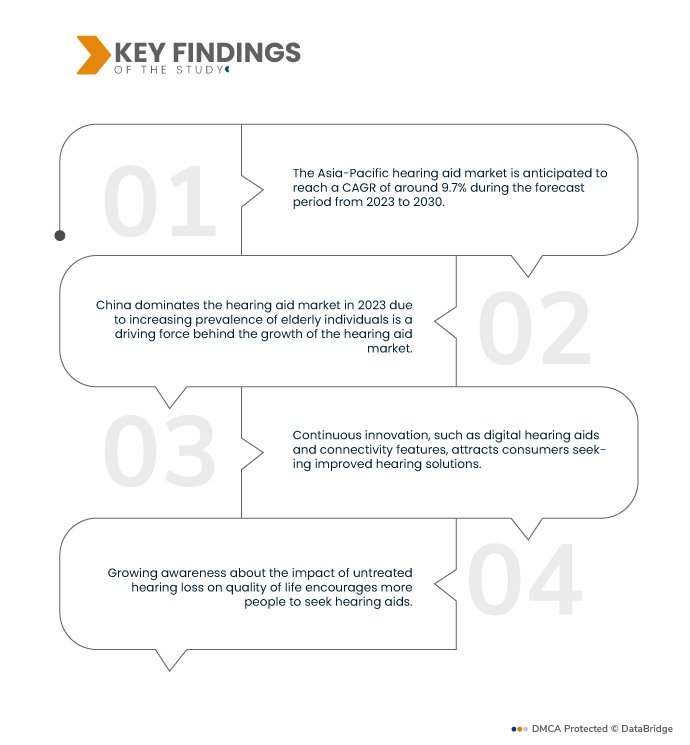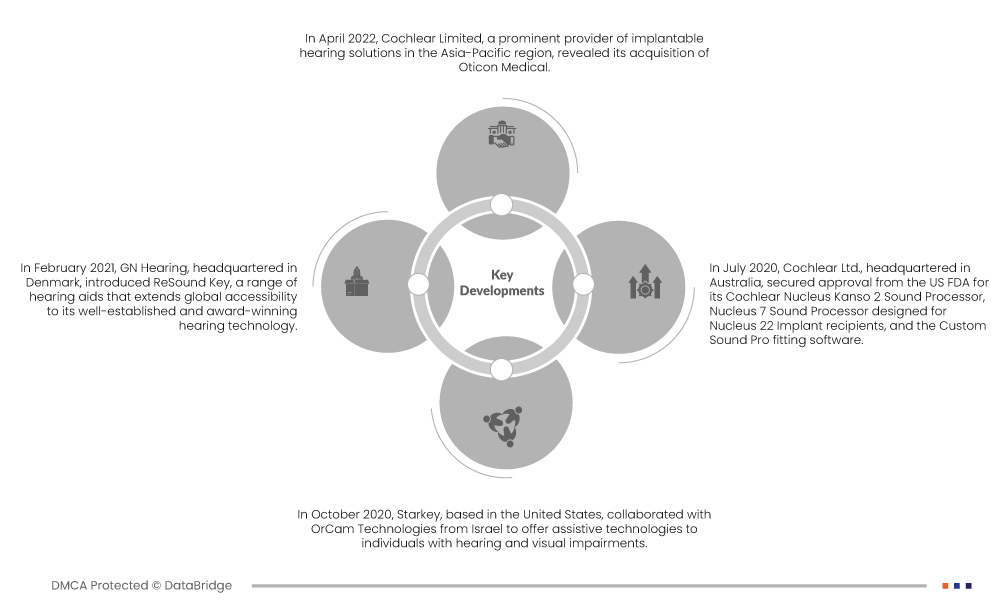Hearing aids are versatile devices designed to improve auditory perception in individuals with hearing impairment. They feature applications such as digital signal processing for sound amplification and noise reduction. Key features of hearing aids include discreet and comfortable designs, customizable settings, and connectivity to smartphones for remote control and audio streaming. These aids are used to address various hearing needs, from mild to profound hearing loss, facilitating better communication, social engagement, and overall quality of life for wearers.
Access Full Report @ https://www.databridgemarketresearch.com/fr/reports/asia-pacific-hearing-aid-market
Data Bridge Market Research analyses that the Asia-Pacific Hearing Aid Market is registering a CAGR of 9.7% during the forecast period of 2023 to 2030. The aging global population, more susceptible to hearing impairment, is a key driver for increased demand in the hearing aid market. As people age, the likelihood of experiencing hearing loss rises, creating a substantial consumer base seeking hearing aids to improve their quality of life and communication abilities.
Key Findings of the Study
Government initiatives are expected to drive the market's growth rate
Supportive policies and initiatives play a crucial role in promoting accessibility to hearing aids. Many governments and healthcare organizations have recognized the importance of hearing health and have introduced programs to subsidize or provide hearing aids to those in need. These initiatives aim to reduce financial barriers, improve affordability, and ensure that individuals with hearing impairments have access to the necessary assistive devices, ultimately enhancing their quality of life and social inclusion.
Report Scope and Market Segmentation
|
Report Metric
|
Details
|
|
Forecast Period
|
2023 to 2030
|
|
Base Year
|
2022
|
|
Historic Years
|
2021 (Customizable to 2015-2020)
|
|
Segments Covered
|
Product Type (Hearing and Device, Hearing Implants, and Hearing & Accessories), Hearing Loss (Sensorineural Loss, Conductive Loss, Mixed Hearing Loss, Auditory Neuropathy Spectrum Disorder (ANSD)), Patient Type (Geriatric, Adults, Pediatrics), Technology (Digital Signal Processing, Wireless Hearing Aid, Directional Microphone Systems, Artificial Intelligence, Digital Noise Reduction, Feedback Management Systems, Data Logging, Telecoil, Tinnitus Masking, and Others), End-Users (Hospitals, Specialty Clinics, Home Care Settings, and Others), Distribution Channel (Direct Tender, Retail Pharmacy, Hospital Pharmacy, Online Sales, and Others).
|
|
Countries Covered
|
Japan, China, South Korea, India, Australia and New Zealand, Taiwan, Hong-Kong, Singapore, Thailand, Malaysia, Indonesia, Philippines, and Rest of Asia-Pacific
|
|
Market Players Covered
|
Sonova (U.S. and Switzerland), WS Audiology A/S (Denmark), GN Hearing (Denmark), Arphi (France), Cochlear Ltd. (Australia), Demant A/S (Denmark), Medtronic (U.S.), Eargo (U.S.), Natus Medical Incorporated (U.S.), Beltone Group (U.S.), Zounds Hearing (U.S.), Amplifoon (Italy), APLS (U.S.), Starkey Laboratories, Inc. (U.S.), Unitron (Canada), Bernafon (Switzerland), Sonic Innovation, Inc. (U.S.), Austar Hearing Science and Technology (Xiamen) Co., Ltd. (China), Boston Scientific Corporation (U.S.), Rion Co. Ltd. (Japan), MED-EL Medical Electronics (Austria)
|
|
Data Points Covered in the Report
|
In addition to the insights on market scenarios such as market value, growth rate, segmentation, geographical coverage, and major players, the market reports curated by the Data Bridge Market Research also include depth expert analysis, patient epidemiology, pipeline analysis, pricing analysis, and regulatory framework
|
Segment Analysis:
The Asia-Pacific hearing aid market is segmented on the basis of product type, hearing loss, patient type, technology, end-users, and distribution channel.
- On the basis of product type, the Asia-Pacific hearing aid market is segmented into hearing and device, hearing implants, and hearing and accessories.
- On the basis of hearing loss, the Asia-Pacific hearing aid market is segmented into sensorineural loss, conductive loss, mixed hearing loss, and auditory neuropathy spectrum disorder (ANSD).
- On the basis of patient type, the Asia-Pacific hearing aid market is segmented into geriatric, adults, and paediatrics.
- On the basis of technology, the Asia-Pacific hearing aid market is segmented into digital signal processing, wireless hearing aid, directional microphone systems, artificial intelligence, digital noise reduction, feedback management systems, data logging, telecoil, tinnitus masking, and others.
- On the basis of end-users, the Asia-Pacific hearing aid market is segmented into hospitals, specialty clinics, home care settings, and others.
- On the basis of distribution channel, the Asia-Pacific hearing aid market is segmented into direct tender, retail pharmacy, hospital pharmacy, online sales, and others.
Major Players
Data Bridge Market Research recognizes the following companies as the major Asia-Pacific hearing aid market players in Asia-Pacific hearing aid market are Sonova (U.S. and Switzerland), WS Audiology A/S (Denmark), GN Hearing (Denmark), Arphi (France), Cochlear Ltd. (Australia), Demant A/S (Denmark), Medtronic (U.S.), Eargo (U.S.), Natus Medical Incorporated (U.S.), Beltone Group (U.S.), Zounds Hearing (U.S.), Amplifoon (Italy), APLS (U.S.)
Market Developments
- In April 2022, Cochlear Limited, a prominent provider of implantable hearing solutions in the Asia-Pacific region, revealed its acquisition of Oticon Medical. This strategic move enabled Cochlear to assume control of Demant's hearing implants business operations, significantly expanding its product portfolio and presence in the market.
- In February 2021, GN Hearing, headquartered in Denmark, introduced ReSound Key, a range of hearing aids that extends global accessibility to its well-established and award-winning hearing technology.
- In October 2020, Starkey, based in the United States, collaborated with OrCam Technologies from Israel to offer assistive technologies to individuals with hearing and visual impairments. This partnership bolstered OrCam's capacity to implement their advanced computer vision and machine learning techniques to convey visual information through audio, in conjunction with Starkey's Livio Edge AI hearing aids.
- In July 2020, Cochlear Ltd., headquartered in Australia, secured approval from the US FDA for its Cochlear Nucleus Kanso 2 Sound Processor, Nucleus 7 Sound Processor designed for Nucleus 22 Implant recipients, and the Custom Sound Pro fitting software.
Regional Analysis
Geographically, the countries covered in the Asia-Pacific hearing aid market report are Japan, China, South Korea, India, Australia and New Zealand, Taiwan, Hong-Kong, Singapore, Thailand, Malaysia, Indonesia, Philippines and Rest of Asia-Pacific
As per Data Bridge Market Research analysis:
China dominates Asia-Pacific in hearing aid market during the forecast period 2023 - 2030
In 2023, China will dominate the Asia-Pacific hearing aid market as the global population ages, and the incidence of age-related hearing loss rises significantly. Hearing aids have become essential for enhancing the auditory experience and quality of life for seniors. These devices address age-related hearing impairments, ensuring that older individuals can actively engage in conversations, enjoy entertainment, and maintain social connections. The growing number of elderly people necessitates the availability and advancement of hearing aid technologies to cater to their unique hearing needs, thus fueling market expansion.
For more detailed information about the hearing aid market report, click here – https://www.databridgemarketresearch.com/fr/reports/asia-pacific-hearing-aid-market















